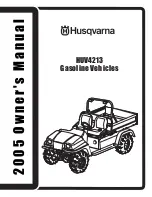
OPERATION AND SERVICE INFORMATION
Page 25
Owner’s Manual and Service Guide
Read all of Manual to become thoroughly familiar with this vehicle. Pay particular attention to all Notes, Cautions and Warnings
•
The charger connector/cord set is protected from
damage and is located in an area to prevent injury
that may result from personnel running over or
tripping over the cord set.
•
The charger is automatically turned off during the
connect/disconnect cycle and therefore no electri-
cal arc is generated at the DC plug/receptacle
contacts.
In some portable chargers, there will be a rattle present in the
body of the charger DC plug. This rattle is caused by an internal
magnet contained within the charger plug. The magnet is part
of the interlock system that prevents the vehicle from being
driven when the charger plug is inserted in the vehicle charging
receptacle.
AC Voltage
Battery charger output is directly related to the input volt-
age. If multiple vehicles are receiving an incomplete
charge in a normally adequate time period, low AC volt-
age could be the cause and the power company should
be consulted.
TROUBLESHOOTING
In general, troubleshooting will be done for two distinct
reasons. First, a battery that performs poorly and is out-
side of the manufacturers specification should be identi-
fied in order to replace it under the terms of the
manufacturer’s warranty. Different manufacturers have
different requirements. Consult the battery manufacturer
or a manufacturer representative for specific require-
ments.
The second reason is to determine why a particular vehi-
cle does not perform adequately. Performance problems
may result in a vehicle that runs slowly or in a vehicle that
is unable to operate for the time required.
A new battery must
mature
before it will develop its max-
imum capacity. Maturing may take up to 100 charge/dis-
charge cycles. After the maturing phase, the older a
battery gets, the lower the capacity. The only way to
determine the capacity of a battery is to perform a load
test using a discharge machine following manufacturer’s
recommendations.
A cost effective way to identify a poorly performing bat-
tery is to use a hydrometer to identify a battery in a set
with a lower than normal specific gravity. Once the partic-
ular cell or cells that are the problem are identified, the
suspect battery can be removed and replaced. At this
point there is nothing that can be done to salvage the
battery; however, the individual battery should be
replaced with a good battery of the same brand, type and
approximate age.
Hydrometer
A hydrometer (P/N 50900-G1) is used to test the state of
charge of a battery cell (Ref Fig. 32 on page 26). This is
performed by measuring the density of the electrolyte,
which is accomplished by measuring the specific gravity
of the electrolyte. The greater the concentration of sulfu-
ric acid, the more dense the electrolyte becomes. The
higher the density, the higher the state of charge.
To prevent battery explosion that could result in
severe personal injury or death, never insert a
metal thermometer into a battery. Use a
hydrometer with a built in thermometer that is
designed for testing batteries.
Specific gravity is the measurement of a liquid that is
compared to a baseline. The baseline is water which is
assigned a base number of 1.000. The concentration of
sulfuric acid to water in a new golf car battery is 1.280
which means that the electrolyte weighs 1.280 times the
weight of the same volume of water. A fully charged bat-
tery will test at 1.275 - 1.280 while a discharged battery
will read in the 1.140 range.
Do not perform a hydrometer test on a battery that has just
been watered. The battery must go through at least one charge
and discharge cycle in order to permit the water to adequately
mix with the electrolyte.
The temperature of the
electrolyte
is important since the
hydrometer reading must be corrected to 80° F (27° C).
High quality hydrometers are equipped with an internal
thermometer that will measure the temperature of the
electrolyte and will include a conversion scale to correct
the float reading. It is important to recognize that the
electrolyte temperature is significantly different from the
ambient temperature if the vehicle has been operated.
Summary of Contents for 2007 COMMANDER 2100
Page 8: ...Page vi Owner s Manual and Service Guide TABLE OF CONTENTS Notes...
Page 12: ...Owner s Manual and Service Guide Notes Page x SAFETY INFORMATION...
Page 45: ...Page 27 GENERAL SPECIFICATIONS Owner s Manual and Service Guide GENERAL SPECIFICATIONS...
Page 50: ...Page 32 Owner s Manual and Service Guide GENERAL SPECIFICATIONS Notes...
Page 51: ...Appendix A 1 Owner s Manual and Service Guide LABELS AND PICTOGRAMS LABELS AND PICTOGRAMS...
Page 56: ...Appendix A 6 Owner s Manual and Service Guide LABELS AND PICTOGRAMS...
Page 57: ...Appendix B 1 Owner s Manual and Service Guide WARRANTY LIMITED WARRANTIES...
Page 60: ...Appendix C 2 Owner s Manual and Service Guide DECLARATION OF CONFORMITY...
Page 61: ...Appendix C 3 Owner s Manual and Service Guide DECLARATION OF CONFORMITY...
Page 62: ...Appendix C 4 Owner s Manual and Service Guide DECLARATION OF CONFORMITY...
















































